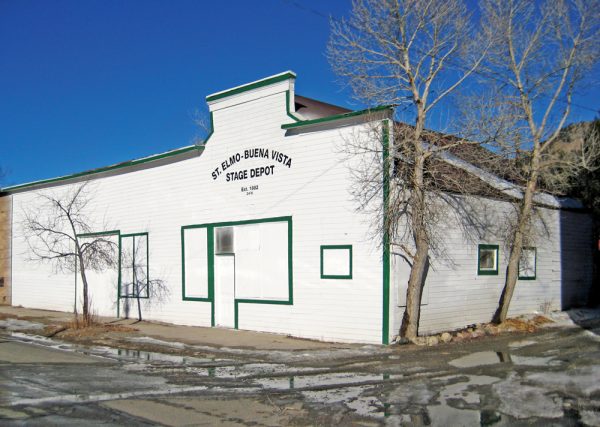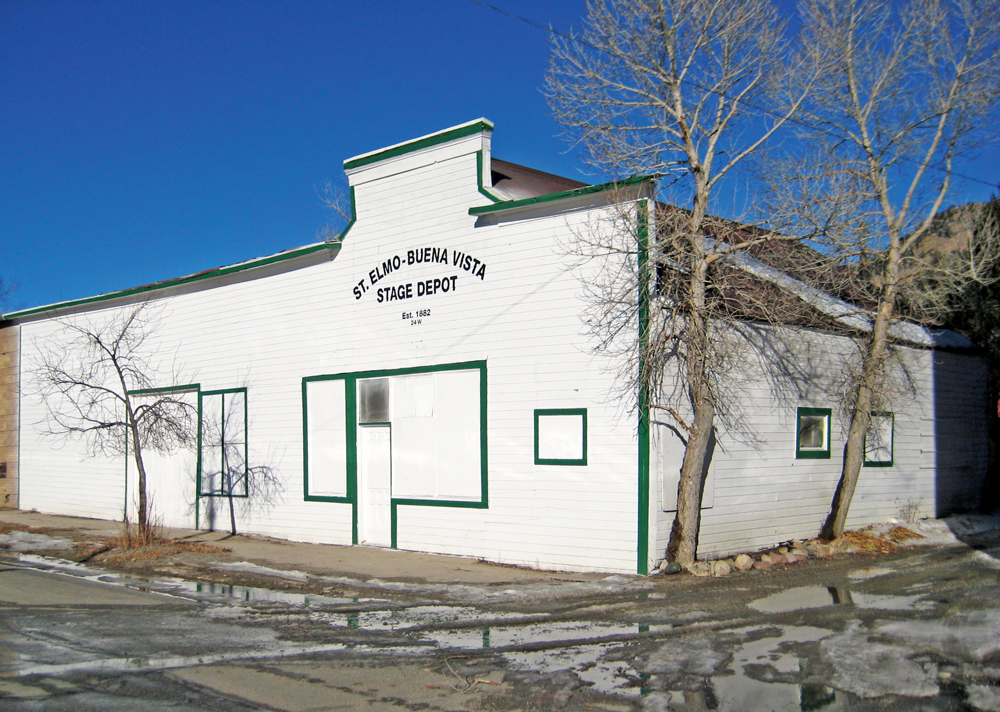By Fay Golson for The Chaffee County Heritage Area Advisory Board
The St. Julien Livery in downtown Buena Vista is the eighth property featured from the Chaffee County Historic Resources Survey. The 0.39-acre property is located at the southwest corner of Chestnut Street and Railroad Avenue. The building not only served as a livery but also, a few years after opening, as an ice and coal store. During their time, livery stables were vital to towns throughout America.

As a fan of western movies, I had some idea of what a livery stable is – a place for gunfight dramas, a place where white– or black–hat cowboys could leave the horses for a night’s rest while they headed for the saloon, boarding house or elsewhere. It seems a livery stable was much more than the western movie stereotype. It was a type of horse residence that maintainedhorses, teams and wagons for hire. Privately owned horses could also be boarded. It was a rental facility for the transport of heavy cargo, such as caskets. The business was often near a hotel, boardinghouse or stage stop. The Daily Progress of Charlottesville, VA reports, “These establishments often offered pickup and delivery services for people, as well as for heavy items. If one needed to move a heavy object like a dresser, visit a relative in the country or just take a Sunday ride, it all started at the nearby livery. Nearly as important as the transportation they provided, these places also served as gathering points for men and boys. Perhaps with sprigs of hay being worried back and forth in their mouths, old-timers and young men would regale each other with stories, as boys looked on with wide-eyed wonder.”
The enterprise dates back to the late 1890s. The first large significant stable was the C. W. Miller Livery Stable in Buffalo, NY. It is listed in the National Register of Historic Places and was notable for its innovative design. According to the nomination document, “Designed by Lansing and Beierl and built between 1892 and 1894, the six-story building incorporated innovative structural solutions … The design of the building addressed lighting, heating, plumbing, waste removal, and fire suppression with the latest available technologies while creating a distinctive facade compatible in scale and style with the commercial architecture of downtown … Charles W. Miller was a prominent Buffalo businessman who made his fortune in the urban horse transportation business. The local press hailed the building as a “palace for horses” and claimed it was the finest stable in the country.”
According to Front Range Research Associates (FRRA), St. Julien Livery dates back to 1882. Henry and Emma Moody purchased the property from the Buena Vista Land Company in 1879. Mr. Moody, Buena Vista’s justice of the peace, built the structure before 1882, as it is shown on the town’s bird’s-eye-view map dated that year. In 1883, Anthony Bott and Charles Anchinoole acquired the property. The 1886 Sanborn fire insurance map designated the building as the St. Julien Livery. The building retained the label “horse hotel livery” from 1896 through 1926. Martin Luther Mason acquired the property in 1905 and maintained ownership until 1943. The coal and ice business became a convenient addition to the livery business – one-stop shopping, you might say. Orley Mason joined his father, changing the name to Mason & Son. After his father’s death in 1915, Orley must have recognized the increasing importance of automobiles, as he created a garage facility in the building. The business continued to operate as a livery and a coal and ice outlet. An upstanding citizen, Orley was elected as Chaffee County Commissioner in 1916 and served until 1920. The property was passed on to several owners, the last being Phillip and Dorothy German in 1946. After Phillip’s death in 1956, Dorothy and her son, Edde, continued the business until 1960. As stated by FRRA, the assessor appraisal card indicates that there has been no commercial use in the building since 1972. Edde and Mary Lou German remain owners of the property.
The St. Julien Livery, a false-front, irregularly shaped building, is significant in the area of commerce in Buena Vista, and it is an architectural example of early false-front construction in the town. When viewing any historic photograph of Main Street, one will see how prevalent this form of construction was. With the advent of the automobile after 1910, the livery stable enterprise throughout America quietly disappeared. Many buildings have been repurposed or destroyed. In our county, we are fortunate to have two that are listed in the Chaffee County Historic Resources Survey: St. Julien Livery and Granite Stage Stop and Livery Stable.
Fay Golson is a preservationist, artist and aspiring writer living in Chaffee County, an area brimming with historic resources. She has authored several National Register of Historic Places Nominations and now can be found in her Salida art studio or among the stacks at the Salida Regional Library, frantically searching for historic references.


